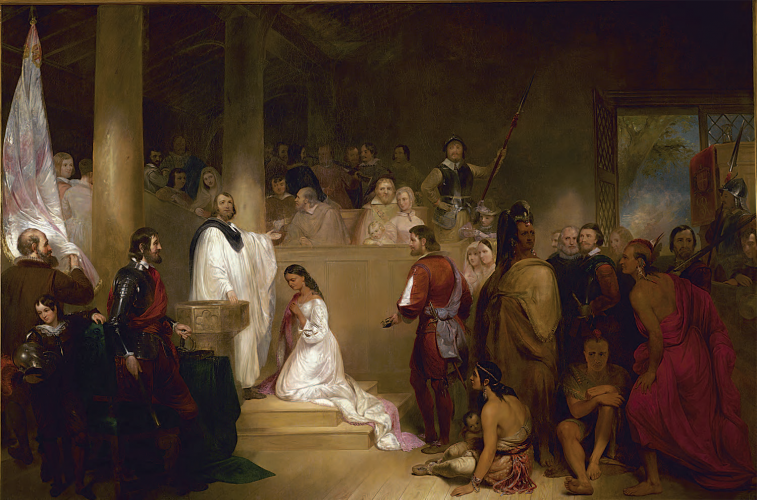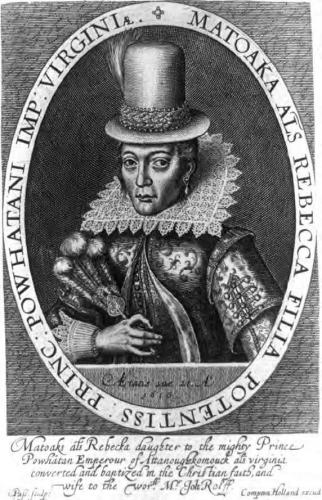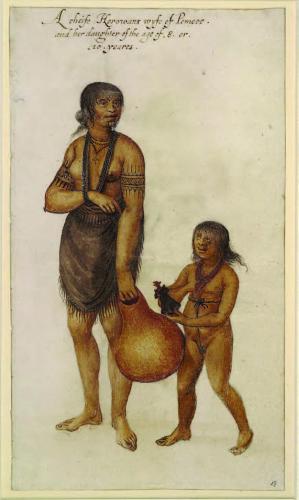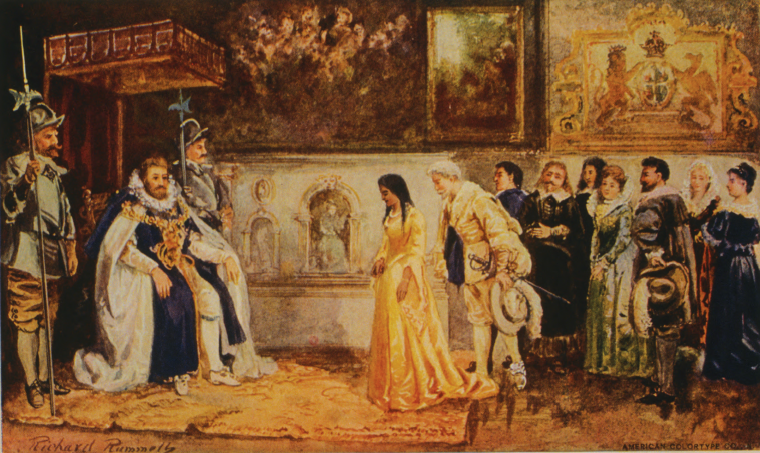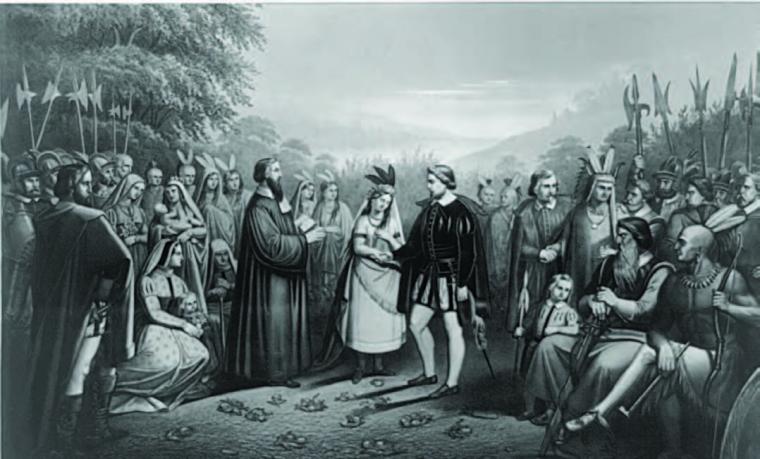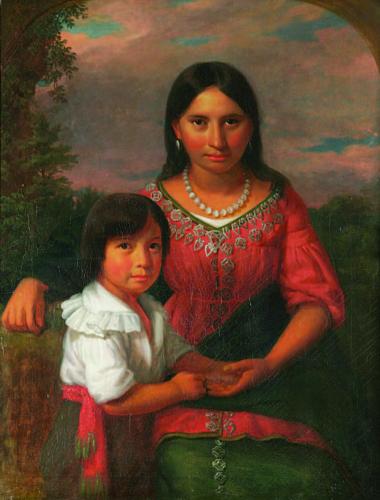Rebecca Rolfe. This was the name chosen by Pocahontas, the spirited daughter of Powhatan, when she grew up to be a wife and mother. This phase of her life was even more historically significant than her legendary childhood. Defying barriers raised by her own people and by the English, it was marked by a name change of great meaning, just as her birth name Matoaka was replaced by a nickname meaning willful child. But in all the writing about this fascinating woman, very few ask why she selected Rebecca, a Biblical figure fraught with significance for Jamestown.
Part of the answer lies with the two men involved in her marriage, her husband John Rolfe (1585–1622) and the minister who converted her, Alexander Whitaker (1585–1617). They both became involved with Matoaka in 1613 when she had been kidnapped and brought to Jamestown as a hostage against renewed hostilities with her father, head of the Powhatan tribal empire. The governor, Sir Thomas Dale, entrusted her to the young minister Whitaker at the new, well-fortified outpost, Henrico, for Christian instruction and conversion. The widower Rolfe was a frequent visitor.
Governor Dale sent Powhatan a series of demands for the return of the hostage. The old chief reluctantly complied with most, the return of eight English captives and some of the muskets, swords and tools he had seized, but he tried to hold onto the rest, “which it delighted him to view, and look upon.”
After a year of delay, Dale forced the issue, leading an expedition to Powhatan’s territory with Pocahontas in tow. In the midst of the parleys, Pocahontas sprang a series of surprises. During her long captivity, she and her sometime guard Rolfe had fallen in love. She went ashore to talk to her brothers, ignoring her other tribesmen, and said coolly that if her father had loved her, he would not value her less than old swords, muskets and axes. Therefore she would stay with the Englishmen, who loved her.
At the same time, Rolfe, the Englishman who did love her, sent a letter to Dale asking permission to marry her. This double announcement, apparently orchestrated by the two, gave Dale and Powhatan a way out of their impasse. Both leaders approved the match and Rolfe married Pocahontas, now Rebecca, the following month, on April 5, 1614, in the church at Jamestown. Two of her brothers attended, and an elderly uncle named Opachisco gave her away.
This story was told by Ralph Hamor (1589–1626), secretary to the Virginia council, in a pamphlet published in London in 1615. The book A True Discourse of the Estate of Affairs in Virginia was part of the advance publicity for Pocahontas’ visit to England on behalf of the Virginia Company and helped to make her an international celebrity. (Hamor’s book also preceded Captain John Smith’s account of Pocahontas by nearly a decade, but that is another story.)
Indian feminist writers these days see the conversion and marriage of Pocahontas as her own manipulation of the white man or as the result of coercion, or brainwashing, but this view seriously underestimates this remarkable, headstrong woman. Her voice, when it emerges as in Hamor’s account, is self-assured and even acerbic. She handled herself with aplomb amidst the highest society in London. The famous Simon van de Passe portrait of 1616 shows her haughtily wearing a Jacobean tunic and a perhaps uncomfortable high lace collar and fixing the viewer with a penetrating, intelligent gaze. The whole course of her life argues against the idea that she was a passive, bewildered victim.
Our concern, however, is the European attitude. The barrier to inter-marriage was much higher for the English settlers than for Native tribes, who often relied on marriages and sexual partnerships to seal alliances.
In one famous departing sermon, the adventurers to Virginia heard the admonition, “They may not marry nor give in marriage to the heathen, that are uncircumcised.” William Symonds offered this aside in his April 25, 1609, sermon at Whitechapel, and continued, “The breaking of this rule, may breake the neck of all good successe of this voyage.” Old Testament injunctions from the Babylonian captivity were harsh and explicit. “Ye shall not give your daughters unto their sons, nor take their daughters unto your sons, or for yourselves.” (Nehemiah 13:25. Also Ezra 9:10-12).
Rolfe was well aware that he defied these injunctions. He defended his decision in a famous letter to Governor Dale, which Hamor had delivered to Sir Thomas and, perhaps to the newlyweds’ chagrin, also published in his book. Rolfe said that he had meditated on the warnings against “marrying strange wives, nor of the inconveniences which may therefore arise.”
In prose as tortured as his conscience, Rolfe concluded that two concerns superseded and purified a “merely carnal” attraction. One was the safety of the colony, which would be advanced by a marriage alliance. The other was the conversion and salvation of Pocahontas/Matoaka herself. “Why dost not thou indeavor to make her a Christian?” Rolfe asked himself.
“Likewise, adding hereunto her great appearance of love to me, her desire to be taught and instructed in the knowledge of God, her capablenesse of understanding, her aptness and willingnesse to receive anie good impression, and also the spirituall, besides her owne incitements stirring me up hereunto.”
Rolfe received “no small encouragement” in this course by his “conference with honest and religious persons.”
One of these men was undoubtedly the Rev. Alexander Whitaker, spiritual mentor to Pocahontas. Whitaker is already known as “the Apostle of Virginia,” but his historical standing would be much higher if he had lived longer (he drowned at the age of 32 crossing the James River) and if more of his writings had survived. His education and intellectual ability were outstanding. His father, Dr. William Whitaker, was master of St. John’s College at Cambridge and a leading Church of England theologian with Calvinist leanings.
Alexander answered the call to emigrate to Virginia in 1611, leaving a comfortable position. His main surviving work Good Newes from Virginia was published in 1613. Although it predated his encounter with Matoaka, it laid the intellectual foundation for her marriage and much that followed. His interest in the Indian population, and his emphasis on their human rights, is particularly illuminating when read in conjunction with John Rolfe’s letter.
Whitaker describes the Virginia natives as “naked slaves of the divell” but quickly blames their condition on their awe of the Powhatan priesthood, the Quiokosoughs (an elaborate institution relatively rare in North American tribes). He compares the Quiokosoughs to English witches and reminds the reader of the benighted state of England “before the Gospell was preached in our Countrey.” The language is jarring to modern ears, but it leads to a surprisingly broad-minded conclusion. The comparison to ancient Britain was meant to emphasize their common humanity. It echoes the famous report by Thomas Harriot and the artist and Roanoke Governor John White, which included pictures of the ancient Picts, “to showe how that the inhabitants of the great Bretannie have bin in times past as sauvage as those of Virginia.”
Even though Whitaker calls the Powhatan priests “Sathan’s own brood,” he shows a lively curiosity about their conduct and promises to study it further. “When I have more perfectly entered into their secrets, you shall know all.”
Moreover he sees an obligation to rescue the “miserable people” under their spell. “One God created us, they have reasonable soules and intellectual faculties as well as wee: we all have Adam for our common parent: yea, by nature the condition of us both is all one, the servants of sinne and slaves of the divell.” Whitaker carries the argument further in a very important sentence. “Finally, there is a civill government amongst them which they strictly observe, and show thereby that the law of Nature dwelleth in them.” This statement is more than an echo of a famous 1532 lecture by the Spanish jurist and Dominican theologian Francisco de Vitoria (1480?–1546); it is a precis of Vitoria’s thesis, which is now widely cited as a foundation of modern human rights.
Vitoria’s lecture “On the Indians Lately Discovered” addressed the rights of the indigenous peoples of the Americas in the face of Spanish conquest. To those raised in the shadow of the Elizabethan “Black Legend” of Spanish cruelty, it is a major surprise to learn that Vitoria, the eminent Dominican and theology professor at the University of Salamanca, condemned the conquistadors and defended the rights of the Indians. Vitoria’s basic point, after a prolonged medieval-style back-and-forth, was that Indians had basic political and property rights because they possessed the basic human quality of reason. “This is clear, because there is a certain method in their affairs, for they have polities which are orderly arranged and they have definite marriage and magistrates, overlords, laws and workshops, and a system of exchange, all of which call for the use of reason; they also have a kind of religion.” It didn’t matter that their government or religion sometimes sanctioned evil deeds, even human sacrifice, or that they were pagans. The capacity for organization demonstrated human reason; in Aristotelean terms, Indians were political animals and thus possessed human souls.
This emphasis on common humanity justified Whitaker in his labors to educate Pocahontas and Rolfe in his proposal of marriage. The Biblical barriers, in their view and in the view of current traditionalist authorities, were not based on biology or an anachronistic pseudo-science of racism; they dealt with divides in language, culture and religion which could be overcome by human effort and divine grace.
This message, moreover, would have come across strongly in Whitaker’s education of the intelligent young lady, capable of understanding and apt and willing to receive instruction. In his teaching of religious principles, it would be surprising if he did not use the document prepared by his own father, A Short Summe of Christianity. Delivered by way of Catechism. This popular book was a clear and concise distillation of Calvinist doctrine.
In Calvin’s own explanation, all humanity is “damned and forlorn by nature. Hath not the devil a tyrannical domination over us, from whence no man can deliver himself by his own power.” Deliverance from this domination comes not from human merit, “but from the peculiar mercy of God.”
But this doctrine argues strongly against the current academic effort to build a Puritan “Black Legend.” Some indigenously oriented scholars maintain that the Euro-American invaders demonized the Natives as children of Satan and thus justified dispossession and genocide. This historiography has plenty of material to work with, but it ignores the acceptance in the 16th and 17th centuries by theologians such as Vitoria and Whitaker of the fundamental principle of universal human rights and the Calvinist insistence that all humans are in the same boat.
No matter how many statements one compiles to the effect that Indians are “children of the divell” or “slaves to Sathan,” one has to acknowledge that to a Calvinist, all members of humanity are conceived in sin and enslaved to the devil, except for the Immaculate Conception. There is no warrant here for murder and dispossession.
We can’t say whether or to what extent Alexander Whitaker engaged in such discussions with his ward, but we do know he was pleased with the result. In a short letter home, printed in Hamor alongside Rolfe’s soul-searching, he reported the marriage of “Pocahuntas or Matoa the daughter of Powhatan” as “that which is best” of the news from the colony. And, as a Biblical scholar, he was certainly involved in the next step in this project, the daring decision to christen Pocahontas/Matoaka as Rebecca.
To understand how provocative this choice was, look to the original Rebekah in Genesis, chapter 24, the chosen wife of the second patriarch Isaac. Abraham, the first patriarch, was originally a city boy from the prosperous civilization of Mesopotamia; he had been ordered by God to emigrate to a wilderness surrounded by alien peoples. In arranging a marriage for his son, Abraham instructed his major domo in a solemn oath “that thou shalt not take a wife unto my son of the daughters of the Canaanites, among whom I dwell.” The wife was to come from Abraham’s homeland and his kindred. But the bride must emigrate to Canaan to found a great nation; under no circumstances was Isaac to return to Mesopotamia. The servant journeyed to Mesopotamia and at the city of Nahor encountered Rebekah, the great-grand-daughter of Abraham’s brother. She agreed to return with him, with her family’s blessing, “Be thou the mother of thousands of millions.” This story is so important to Israelite identity that the Bible tells it twice.
It would not have been lost on a Biblical scholar of Whitaker’s quality that in accepting the name Rebecca, the new bride was stepping into the role of “mother of thousands of millions.” She was to be the foundation of a new people, sent far away from its homeland and never to return. But the analogy took a breathtaking reversal; instead of coming from the homeland, the new Rebecca was in fact “a daughter of the Canaanites.” Rolfe, the equivalent of the patriarch Isaac, was turning to the surrounding peoples, not his faraway kindred, to find a wife. It is hard to believe that none of these thoughts crossed Whitaker’s mind, and possibly that of Pocahontas too. The name was at the least a deliberate defiance of preachers like William Symonds. One can even see in the choice of the name a glimmering awareness that a new national identity, an amalgamation of Indian and English, was in the making.
This article is adapted from a paper delivered at the Virginia Forum on March 23, 2013, at Randolph-Macon College.
The National Museum of the American Indian gratefully acknowledges the generosity of Mrs. Philip E. Nuttle and the Barksdale Dabney Patrick Henry Family Fund, which supports museum research and scholarship.

